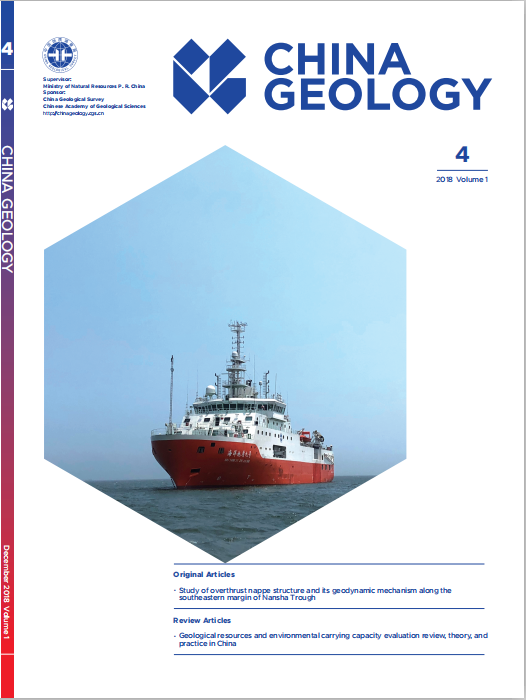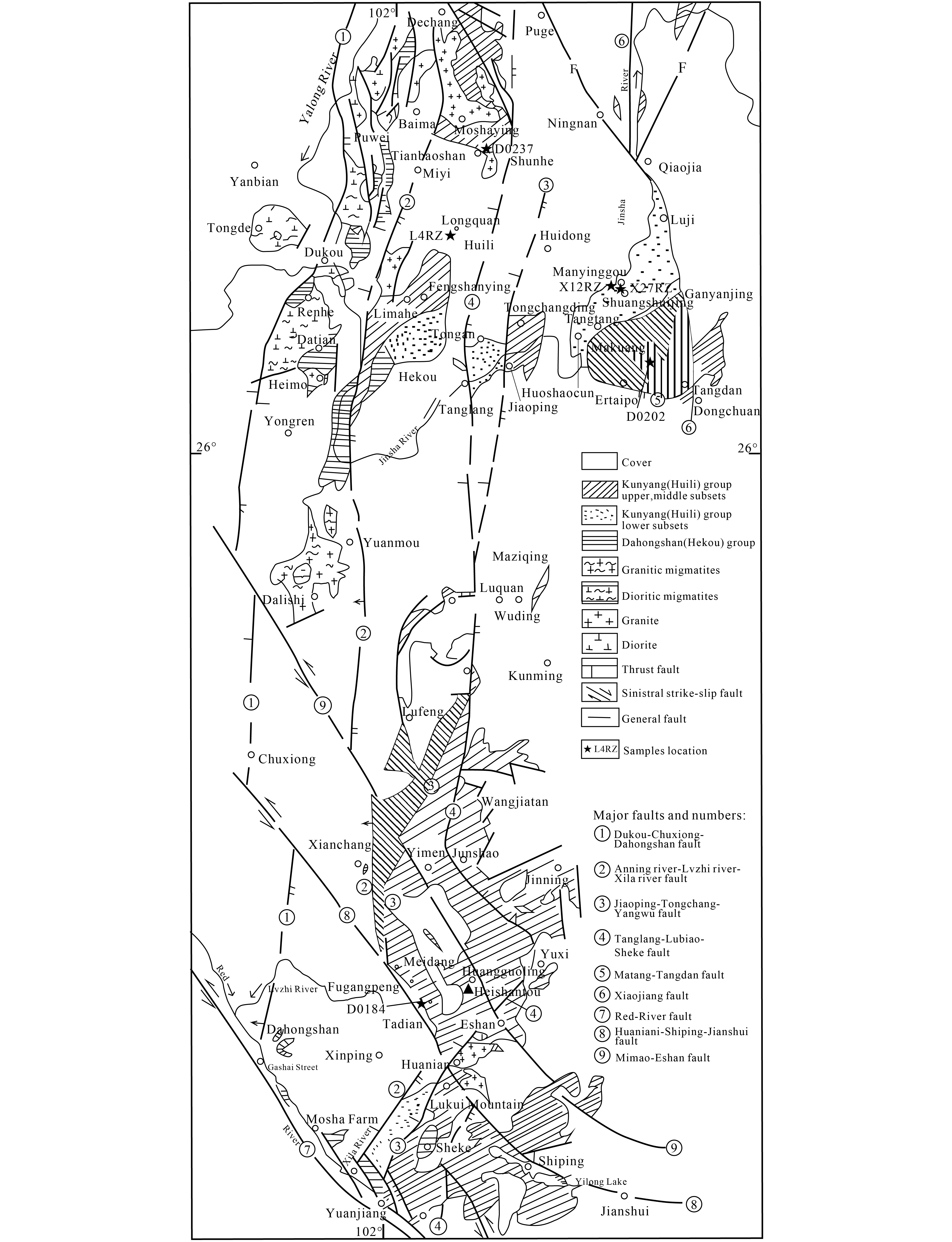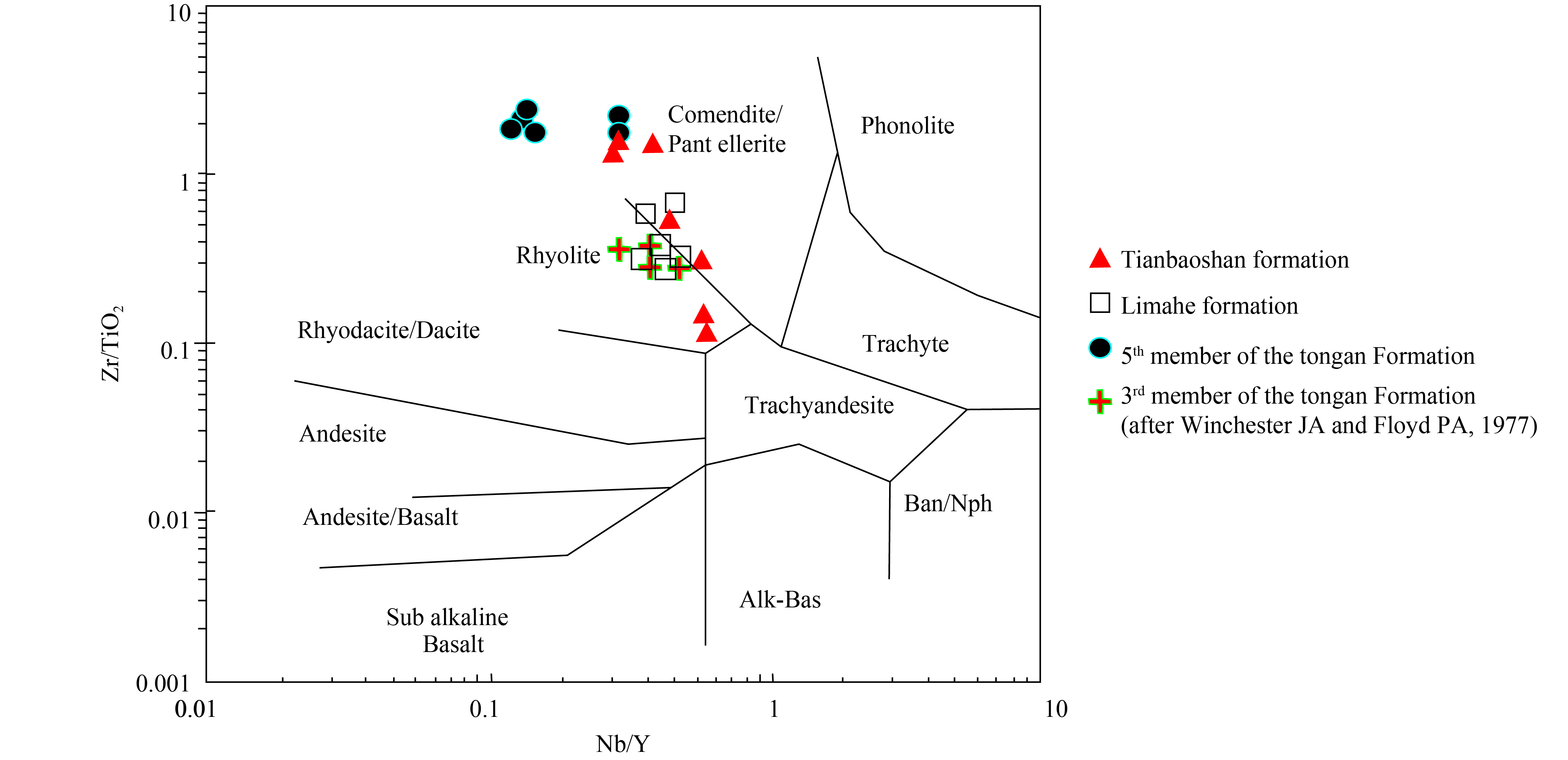| Citation: | Fu-guang Yin, Zhi-ming Sun, Guang-ming Ren, 2018. Early-middle Mesoproterozoic tectonic evolutionary history of the southwestern Yangtze Block, China: lithostratigraphic, geochronologic and elemental geochemical constraints, China Geology, 1, 540-555. doi: 10.31035/cg2018048 |
Early-middle Mesoproterozoic tectonic evolutionary history of the southwestern Yangtze Block, China: lithostratigraphic, geochronologic and elemental geochemical constraints
-
Abstract
During the Early-Middle Proterozoic era, three major lithostratigraphic unit associations, namely Hekou-Dahongshan, Dongchuan, and Kunyang-Huili Groups, were established for the metamorphosed volcanic-sedimentary rocks exposed in the southwestern Yangtze Block (SWYB). The integration of petrology, geochemistry and geochronology constrains tectonic framework and evolution of the SWYB, in which four sets of SHRIMP U-Pb zircon ages were obtained from the volcanic rocks interbedded within the Middle Proterozoic successions: 1800–1600 Ma, 1600–1300 Ma, 1300–1100 Ma, and 1100–1000 Ma. Major and trace elemental analysis indicate that four key tectonic evolutionary stages, each coinciding with the above radiometric age set, of the SWYB during the Early-Middle Mesoproterozoic. The SWYB was characterized by an east-westerly trending rift in the Hekou, Dongshan, and Dongchuan areas, and separate basin-forming events during 1800–1600 Ma and 1600–1300 Ma, respectively. In the SWYB, an intracontinental rift basin and a rift basin occurred in the Caiziyuan-Matang and Laowushan areas, respectively in 1300–1100 Ma ago. During 1100–1000 Ma, the SWYB was characterized by the closure of the Caiziyuan-Matang rift-ocean basin, collision between the Huili Blocks and Kunyang Blocks, and presence of volcanic arcs in the Tianbaoshan and Fulingpen areas. Accordingly, the SWYB represents a new basin that records the relatively complete assembly process of the Rodina during the Early-Middle Mesoproterozoic era.
-

-
References
[1] Anderson T. 2002. Correction of common lead in U-Pb analyses that do not report 204 Pb. Chemical geology, 192, 59–79. doi: 10.1016/S0009-2541(02)00195-X [2] Barrat JA, Fourcade S, Jahn BM, Cheminee JL, Capdevila R. 1998. Isotope(Sr, Nd, Nd, O) and trace-element geochemistry of volcanics from the Erta’Ale rang (Ethiopia). Journal of Volcanology and Geothermal Research, 80(1-2), 85–100. doi: 10.1016/S0377-0273(97)00016-4 [3] Cao RJ, Liang YZ, Duan JS. 1984. A discussion of the stratigraphic sequence of the Kunyang Group and its correlation on the basis of the stromatolite assemblage recently discovered and the data of isotopic ages recently determined. Geological Review, 30(1), 69–73. [4] Frey FA, Green DH, Roy SD. 1978. Integrated models of basalt petrogenesis: A study of quartz tholeiites to olivine melilitites from south eastern Australia utilizing geochemical and experimental petrological data. Journal of Petrology, 19(3), 463–513. doi: 10.1093/petrology/19.3.463 [5] Duan JS. 1987. Preliminary discussion on Pre-sinian geological interpretition of isotopic age in Yunnan. Yunnan Geology, 6(2), 179–187. [6] Dai HG. 1997. On the strata, structure and prospecting target area of Kunyang Group and Huili Group in King-Dian region. Yunnan Geology, 16(1), 1–39. [7] Geng YS, Yang CH, Wang XS, Ren LD, Du LL, Zhou XW. 2007. Age of crystalline basement in western margin of Yangtze terrane. Geological Journal of China Universities, 13(3), 429–441. [8] Geng YS. 2008. The evolution of crystalline basement of Yangtze terrane Geological Publishing House.(in Chinese). [9] Greentree MR, Li ZX, Li XH, Wu HC. 2006. Late Mesoproterozoic to earlist NeoProterozoic basin record of the Sibao orrgenesis in western South China and relationship to the assembly of Rodinia. Precambrian Research, 151, 79–100. doi: 10.1016/j.precamres.2006.08.002 [10] Greentree MR, Li ZX. 2008. The oldest known rocks in south–western China: SHRIMP U–Pb magmatic crystallisation age and detrital provenance analysis of the Paleoproterozoic Dahongshan Group. Journal of Asian Earth Sciences, 33, 289–302. doi: 10.1016/j.jseaes.2008.01.001 [11] Guan JL, Zheng LL, Liu JH, Sun ZM, Liu JH. 2011. Zircon SHRIMPU-Pb Age of Diabase in Hekou Area, Huili County, Sichuan Province and Its Geological Significance. Journal of Geology, 85(4), 482–490. [12] Hou KJ, Li YH. 2009. Tian YR. LA-MC-ICP-MS zircon micro-in-situ U-Pb dating technology. Deposit Geology, 28(4), 481–492. [13] Hua YR. 1959. Discussion on stratigraphic division and regional structures of Dongchuan copper mine. Geological Review, 19(4), 23–27. [14] Jian P, Liu DY, Zhang Qi, Zhang FQ, Shi YR, Shi GH, Zhang LQ, Tao H. 2003. SHRIMP dating of ophiolite and leucocratic rocks within ophiolite. Earth Science Frontiers, 10(4), 439–456. [15] Liang YZ, Wu MD, Cao RG, Duan JS. 1982. Discovery of “micro-stromatolite assemblage in the stable conditions” in Kunyang Group and its geological significance. Yunnan Geology, 1(1), 85–87. [16] Li XJ, Wu MD, Duan JS. 1984. The stratigraphic sequence of Kunyang Group and its top and bottom boundaries. Geologial Review, 30(5), 399–408. [17] Li FH, Wang FX, Shen YL, Wang FX, Zhou GF, Pan XN, Li XZ. 1988. The study on the Pre-Sinian of the Kang-Dian region. Chongqing Publishing House, 1988, 1–214. [18] Li ZX, Powell C McA. 1996. Break of Rodinia and Gondwanaland andassembly of Asia. Aust J Earth Sci., 43(4), 591–592. [19] Li XH. 1999. U-Pb zircon ages of granites from the southern margin of the Yangtze Block: timing of Neoproterozoic Jinning Orogeny in SE China and implications for Rodinia assembly. Precambrian Res, 97, 43–57. doi: 10.1016/S0301-9268(99)00020-0 [20] Li ZX, Li XH, Zhou HW, Kinny PD. 2002. Grenvillian continental collisionin south China: New SHRIMP U-Pb zircon results and implications for the configuration of Rodinia. Geology, 30(2), 163–166. doi: 10.1130/0091-7613(2002)030<0163:GCCISC>2.0.CO;2 [21] Li XH, Li ZX, Zhou HW, Liu Y, Liang XR, Li WX. 2003. SHRIMP zirzon U-Pb age, element and Nd isotopic geochemistry of Guandaoshan volcanic rocks in southwest Sichuan: implications for petrogenesis and tectonics. Science in China (series D: Earth Sciences), 46(supplement), 60–68. [22] Li ZX , Li XH , Kinny PD , Wang J. 1999. The breakup of Rodinia: did it start with a mantle plume beneath South China? Earth and Planetary Science Letters, 173(3), 0–181. [23] Liao GY, Zhang XY, Qing RS, Zhou GF, Yao ZD. 1988. The strationtype of the pre-Sinian Tianbaoshan formation in Huli region. Chongqing Publishing House (in Chinese). [24] Liu ZC, Li FY, Zhong KH. 1996. Tectonic Evolution and Mineralization of the Western Margin of the Yangtze Platform. Chengdu:University of Electronic Science and Technology Press. 5-165. [25] Liu DY, Jian P, Zhang Q, Zhang FQ, Shi YR, Shi GH, Zhang LQ. 2003. SHRIMP dating of adakites in the Tulingkai ophiolite, Inner Mongolia: Evidence for the early Paleozoic subduction. Acta Geologica Sinica, 77(3), 317–327. [26] Liu Y, Liu XM, Hu Y C, Yuan HL, Gao S. 2007. Determination of accuracy and long-term stability of 37 elements in Geological Samples by ICP-MS. Journal of petrology, 23(5), 1203–1210. [27] Liu Y, Gao S, Hu Z, Gao C, Zong K, Wang D. 2009. Continental and oceanic crust recycling-induced melt-peridotite interactions in the Trans-North China Orogen: U-Pb dating, Hf isotopes and trace elements in zircons from mantle xenoliths. Journal Petrology, 51, 537–571. [28] Lu SN, Yang CL, Li HK, Chen ZH. 2002. North China continent and Columbia supercontinent. Earth Science Frontiers, 9(9), 226–233. [29] Lv SK, Dai HG. 2001. A review of the set-up of Kunyang Group’ sequence and the discovery of important ore-bearing horizons in Kang-Dian area. Yunnan Geology, 20(1), 1–24. [30] Mou CL, Lin SL, Yu Q. 2000. Sedimentation and evolution of the Mesoproterozoic Kunyang Group in the Huili-Huidong region, Sichuan and its adjacent areas. Sedimentary Geology and Tethyan Geology, 20(1), 44–51. [31] Nasdala L, Hofmeister W, Norberg N, et al. 2008. Zircon M257-A homogeneous natural reference material for the ion microprobe U-Pb analysis of zircon. Geostandards and Geoanalytical Research, 32, 247–265. doi: 10.1111/ggr.2008.32.issue-3 [32] Nick R, Ray M, Godfrey FJ, Rhiannon G, Martin S, Barbara B. 2000. Two mantle plumes beneath the East African rift system: Sr,Nd, and Pb isotope evidence from Kenya Rift basalts. Earth and Planetary Science Letter, 176(3-4), 387–400. doi: 10.1016/S0012-821X(00)00012-1 [33] Pearce JA. 1982. Trace element characteristics of lavas from destructive plate boumdaries . In: Thorps R S (ed). Andesites. New York:John Wiley and Sons, 525-548. [34] Ren GM, Pang WH, Pan GT, Wang LQ, Sun ZM, Yin FG, Cui XZ, Wang DB, Deng Q, Ren F. 2017. Determination of Mesoproterozoic rapeseed Ophiolite melange in the western margin of Yangtze block and its geological significance. Geological Bulletin, 36(11), 2061–2075. [35] Rogers JJW, Santosh M. 2002. Configuration of Columbia, a Mesoproterozoic Supercontinent. Gondwana Research, 5(1), 5–22. doi: 10.1016/S1342-937X(05)70883-2 [36] Song B, Zhang YH, Wan YS. 2002. Discussion on making zircon SHRIMP target, dating age and relative phenomina. Geological Review, 48(supplement), 26–30. [37] Sun SS, Mcdonough WF. 1989. Chemical and isotopic systematics of oceanic basalts: implications for mantle composition and processes. Geological Society London Special Publications, 42(1):313-345. [38] Sun, WH., Zhou MF, Gao JF, Yang YH, Zhao XF, Zhao JH. 2009. Detrital zircon U-Pb geochronological and Lu-Hf isotopic constraints on Detrital zircon U-Pb geochronological and Lu-Hf isotopic constraints on the Precambrian magmatic and crustal evolution of the western Yangtze Block, SW China. Precambrian Research, 172, 99–126. doi: 10.1016/j.precamres.2009.03.010 [39] Sun ZM, Yin FG , Guan JL, Liu JH, Li JM, Geng QR, Wang LQ. 2009. Zircon SHRIMPU-Pb Age of Tuff from Heishan Formation of Kunyang Group in Dongchuan Area, Yunnan Province and Its Stratigraphic Significance. Geological Bulletin, 28(7), 896–900. [40] Winchester, J.A. and Floyd, P.A. 1977. Geochemical Discrimination of Different Magma Series and Their Differentiation Products Using Immobile Elements. Chemical Geology, 20, 325-343. [41] Wood DA. 1980. The application of a Th-Hf-Ta diagram to problems of tectonomagmatic classification and to establishing the nature of crustal contamination of basaltic lavas of the British Tertiary Volcanic Province. Earth and Planetary Science Letters, 50(1), 11–30. doi: 10.1016/0012-821X(80)90116-8 [42] Wu GY. 1987. Geotectonic Environment of Volcanic Rock Formation in Tianbaoshan Formation. Nature exploration, 6(2), 115–124. [43] Wu MD, Duan JS, Song XL. 1990. Geology of the Kunyang Group in Yunnan. Kunming: Yunnan Science and Technology Publishing House, 1990, 1–265. [44] Wu JM, Huang YP, Liu ZC. 1998. The marine volcanic rocks in the western margin of the Yangtze platform and their ore controlling characteristics. Ore Deposit Geology, 17(4), 322–329. [45] Wu GY. 2006. Division of the Precambrian in South China in the light of key geological events. Journal of Stratigraphy, 30(3), 271–286. [46] Yan DP, Zhou MF, Song HL, John Malpas. 2002. where was South China located in the reconstruction of Rodinia-evidence of metamorphic complexes along the western margin of the Yangtze Block and the correlation with Seychells island. Earth Science Frontiers, 9(4), 249–256. [47] Yang ZH, Geng YS, Du LL, Ren LD, Wang XS, Zhou XW, Yang ZS. 2009. Determination of Grenville granite in the western margin of Yangtze block and its geological significance. Geology of China, 36(3), 647–657. [48] Yin FG, Sun ZM, Bai JK. 2011a. Mesoproterozoic stratigraphic framework in Dongchuan and central Yunnan. Journal of stratigraphy, 35(1), 49–54. [49] Yin FG, Sun ZM, Zhang Z. 2011b. The Mesoproterozoic stratigraphic tectonic framework in Huili Dongchuan area. Geological Review, 57(6), 770–778. [50] Yuan HH, Liu SH, Zhang P. 1987. Preliminary outline of the basement age of the Kangdian axis. Refer to: Editor-in-Chief of Zhang YX, Liu BG. Literature Collection of Panxi Rift Valley in China(1). Beijing: Geological Publishing House. 1895. 241-257. [51] Zhang CH, Gao LZ, Wu ZJ, Shi XY, Yan QR, Li DJ. 2007. SHRIMP zircon U-P age of tuff from Kunyang Group in central Yunnan: evidence for Grenvillian phase orogeny in South China. Chinese Science Bulletin, 52(7), 818–824. [52] Zhao QD, Liu ZC, Li FY. 1999. Characteristics and formation environment of the Huili-Dongchuan Proterozoic marine volcanic belt. Rock Minerals, 19(2), 17–24. [53] Zhao JH. and Zhou MF. 2009. Secular evolution of the Neoproterozoic lithospheric mantle underneath the northern margin of the Yangtze Block, South China. Lithos, 107, 152–168. doi: 10.1016/j.lithos.2008.09.017 [54] Zhou MF, Yan DP, Kennedy AK, Li YQ, Ding J. 2002. SHRIMP U-Pb zircon geochronological and geochemical evidence for Neoproterozoic arc-magmatism along the western margin of the Yangtze Block, South China. Earth Planet Sci Lett., 196, 51–67. doi: 10.1016/S0012-821X(01)00595-7 [55] Zhou MF, Nicolas TA, John M, Christina Y W, Allen K K. 2008. Two magma series and associated ore deposit types in the Permian Emeishan large igeous province, SW China. Lithos, 103, 352–368. doi: 10.1016/j.lithos.2007.10.006 -
Access History

-
Figure 1.
Representative Mesoproterozoic successions in the SWYB.
-
Figure 2.
Simplified geological map of the SWYB showing distributions of the Mesoproterozoic to earliest Neoproterozoic rocks and sampling localities with sample number and coordinates shown on Table 2 (modified from Li FH et al., 1988).
-
Figure 3.
CL cg2018048s localities of the point for SHRIMP U-Pb zircons for tuff samples of L4RZ, X12RZ, D0202, X27RZ, D0237, and D0184, respectively.
-
Figure 4.
The concordant plots of SHRIMP U-Pb zircons for tuff samples of L4RZ, X12RZ, D0202, X 27RZ, D0237, and D0184, respectively. Error crosses indicate 1σ errors.
-
Figure 5.
Zr/TiO2 versus Nb/Y rock classification diagrams.
-
Figure 6.
Th–Hf/3–Ta tectonic discrimination plot for basalts (after Wood DA, 1980).
-
Figure 7.
Primitive-mantle normalized spider diagram for the volcanic rocks sampled from the Mesoproterozoic rocks in the SWYB.
-
Figure 8.
Chondrite-normalized REE diagram for the volcanic rocks sampled from the Mesoproterozoic rocks in the SWYB (after Sun SS and McDonough WF, 1989).
-
Figure 9.
Sketch map showing the tectonic evolution of the SWYB during the Mesoproterozoic.





 DownLoad:
DownLoad:







